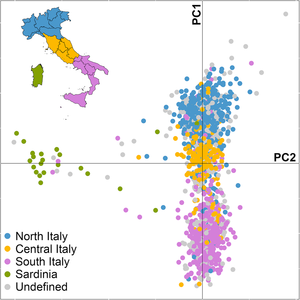| History of Italy |
|---|
 |
|
|

The genetic history of Italy includes information around the formation, ethnogenesis, and other DNA-specific information about the inhabitants of Italy. Modern Italians mostly descend from the ancient peoples of Italy, including Indo-European speakers (Romans and other Latins, Falisci, Picentes, Umbrians, Samnites, Oscans, Sicels and Adriatic Veneti, as well as Magno-Greeks, Cisalpine Gauls and Illyric Iapygians) and pre-Indo-European speakers (Etruscans, Ligures, Rhaetians Camunni, Sicani, Nuragic peoples, as well as settlers from Phoenicia and Carthage). Other groups migrated into Italy as a result of the Roman Empire, when the Italian peninsula attracted people from the various regions of the empire (North Africa, West Asia and the rest of Europe),[2] and during the Middle Ages with the arrival of Ostrogoths, Longobards, Saracens and Normans among others. Based on DNA analysis, there is evidence of regional genetic substructure and continuity within modern Italy dating back to antiquity.[3][4][5][6]
In their admixture ratios, Italians are similar to other Southern Europeans, and that is being of primarily Neolithic Early European Farmer ancestry, along with smaller, but still significant, amounts of Mesolithic Western Hunter-Gatherer, Bronze Age Steppe pastoralist (Indo-European speakers) and Chalcolithic or Bronze Age Iranian/Caucasus-related ancestry.[4][7][8][9]
There is also Bronze/Iron Age West Asian and Middle Eastern admixture in Italy, with a much lower incidence in Northern Italy compared with Central Italy and Southern Italy.[10][8] North African admixture is also found in Southern Italy and the main islands, with the highest incidence being in Sicily and Sardinia.[10][8][4]
- ^ Parolo S, Lisa A, Gentilini D, Di Blasio AM, Barlera S, Nicolis EB, et al. (November 2015). "Characterization of the biological processes shaping the genetic structure of the Italian population". BMC Genetics. 16: 132. doi:10.1186/s12863-015-0293-x. PMC 4640365. PMID 26553317.
- ^ Cite error: The named reference
Antonio_2019was invoked but never defined (see the help page). - ^ Ralph P, Coop G (2013). "The geography of recent genetic ancestry across Europe". PLOS Biology. 11 (5): e1001555. doi:10.1371/journal.pbio.1001555. PMC 3646727. PMID 23667324.
- ^ a b c Raveane A, Aneli S, Montinaro F, Athanasiadis G, Barlera S, Birolo G, et al. (September 2019). "Population structure of modern-day Italians reveals patterns of ancient and archaic ancestries in Southern Europe". Science Advances. 5 (9): eaaw3492. Bibcode:2019SciA....5.3492R. doi:10.1126/sciadv.aaw3492. PMC 6726452. PMID 31517044.
- ^ Capocasa M, Anagnostou P, Bachis V, Battaggia C, Bertoncini S, Biondi G, et al. (2014). "Linguistic, geographic and genetic isolation: a collaborative study of Italian populations". Journal of Anthropological Sciences. 92 (92): 201–31. doi:10.4436/JASS.92001. PMID 24607994.
- ^ Modi A, Lancioni H, Cardinali I, Capodiferro MR, Rambaldi Migliore N, Hussein A, et al. (July 2020). "The mitogenome portrait of Umbria in Central Italy as depicted by contemporary inhabitants and pre-Roman remains". Scientific Reports. 10 (1): 10700. Bibcode:2020NatSR..1010700M. doi:10.1038/s41598-020-67445-0. PMC 7329865. PMID 32612271.
- ^ Cite error: The named reference
Chiang_2018was invoked but never defined (see the help page). - ^ a b c Cite error: The named reference
Marcus_2020was invoked but never defined (see the help page). - ^ Fernandes DM, Mittnik A, Olalde I, Lazaridis I, Cheronet O, Rohland N, et al. (March 2020). "The spread of steppe and Iranian-related ancestry in the islands of the western Mediterranean". Nature Ecology & Evolution. 4 (3): 334–345. Bibcode:2020NatEE...4..334F. doi:10.1038/s41559-020-1102-0. PMC 7080320. PMID 32094539.
- ^ a b Cite error: The named reference
Fiorito_2016was invoked but never defined (see the help page).